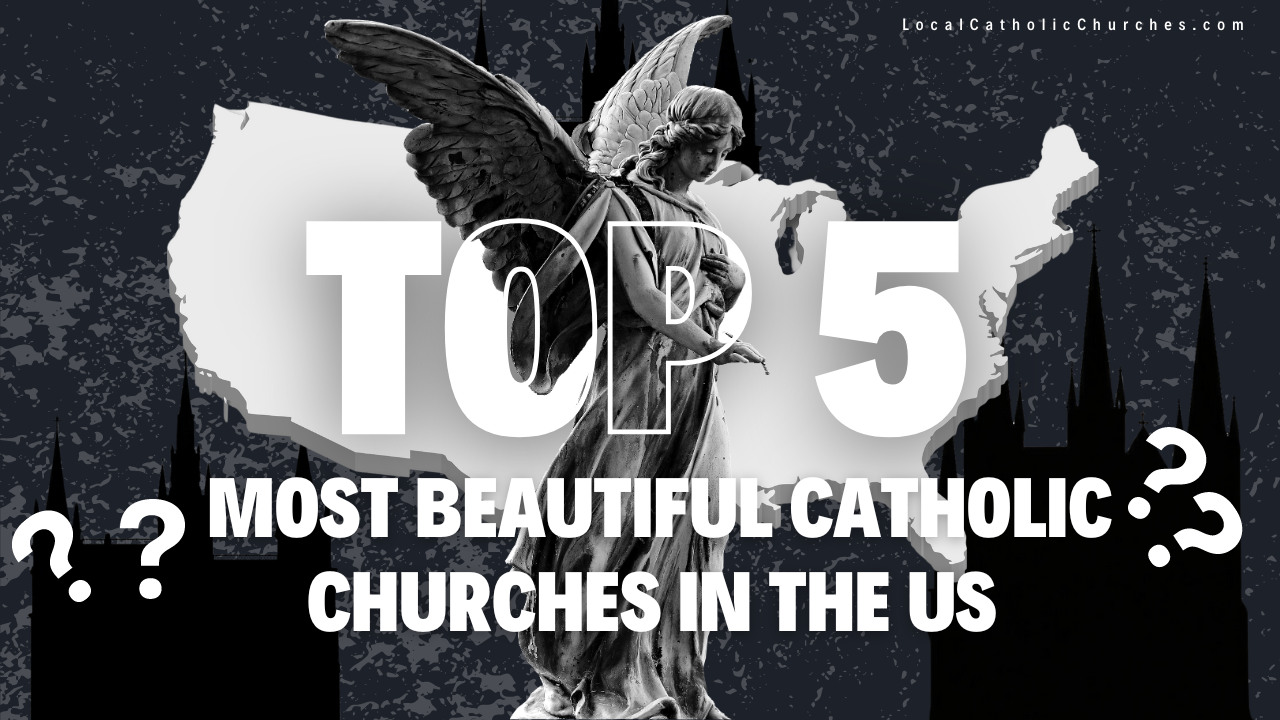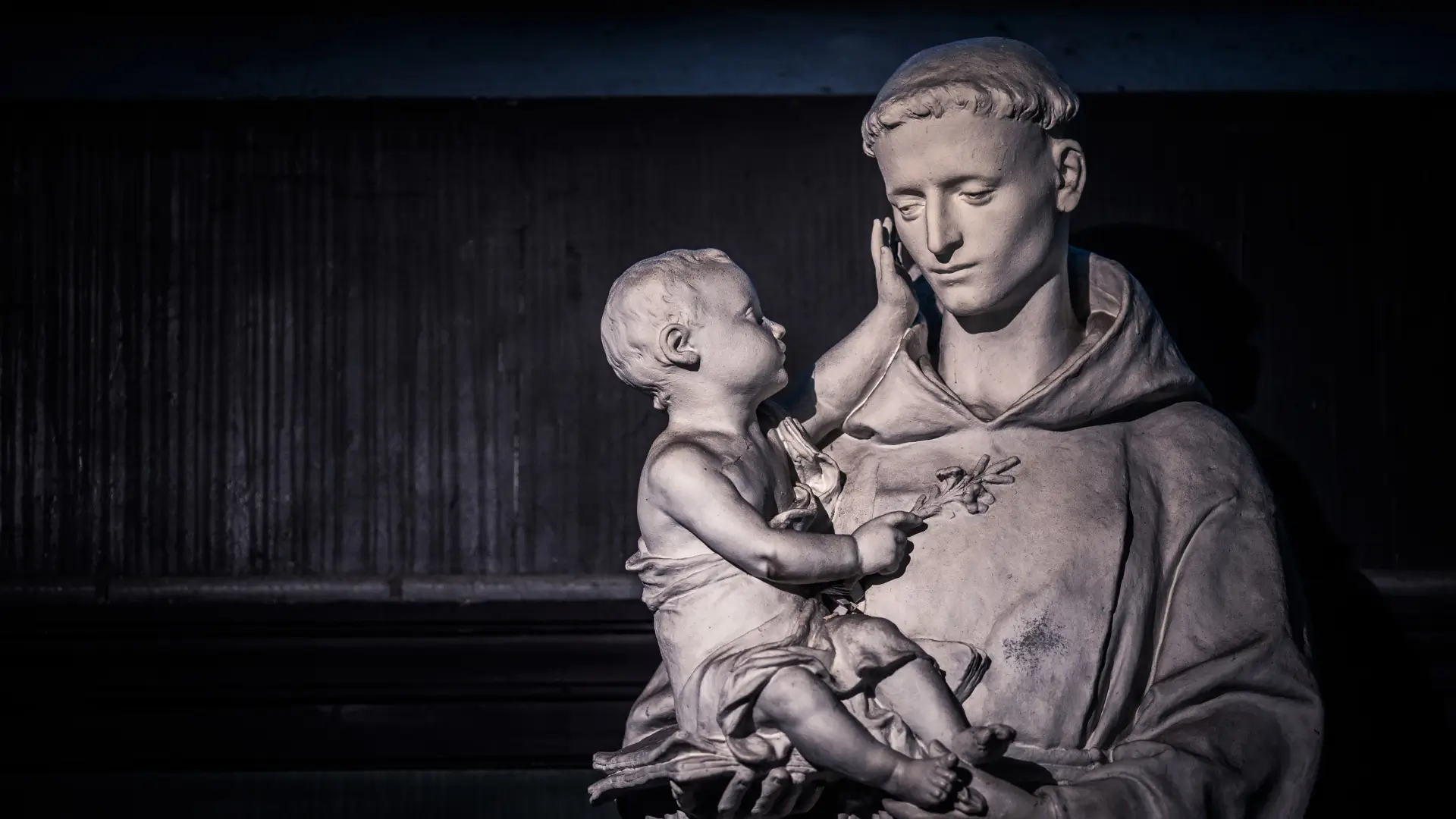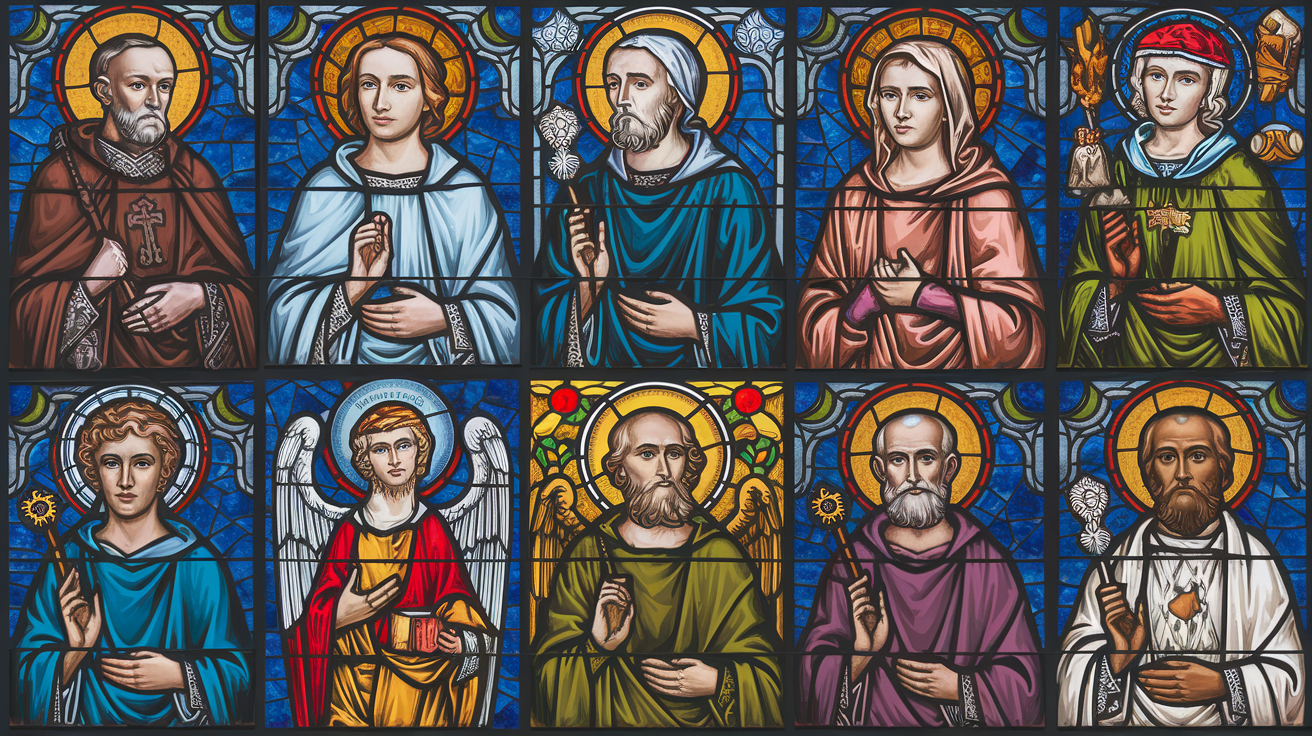The Cathedral of Saint John the Baptist in Savannah, Georgia
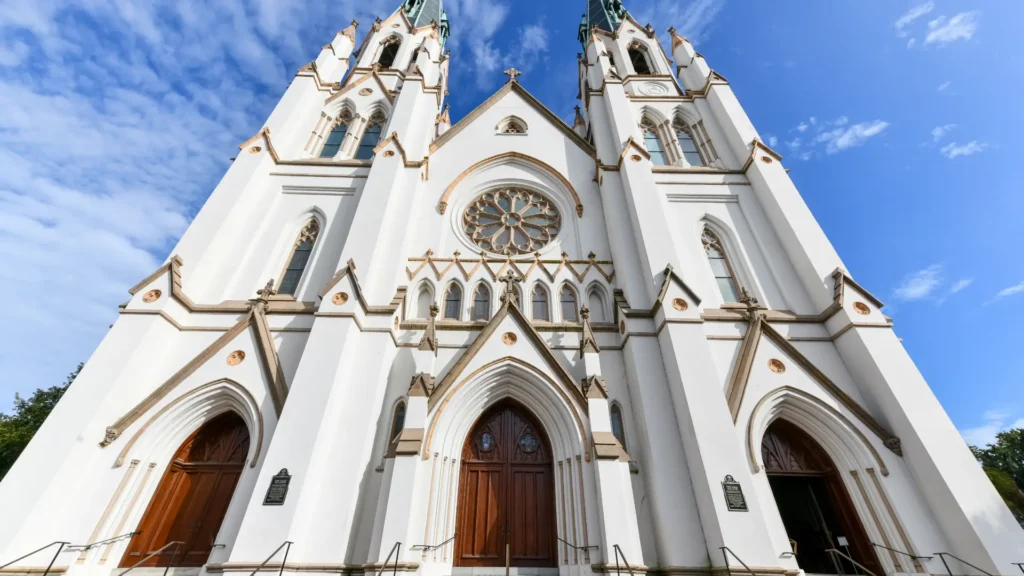
The Rich History of the Cathedral of Saint John the Baptist in Savannah, Georgia
Nestled in the heart of Savannah, Georgia, the Cathedral of Saint John the Baptist stands as a testament to the city’s rich religious heritage and architectural grandeur. Established in the mid-19th century, this stunning cathedral has played a pivotal role in the spiritual and cultural life of Savannah’s Catholic community. The cathedral’s history is a fascinating journey of faith, resilience, and artistic excellence that mirrors the broader narrative of Catholicism in the American South.
Founding and Early Years
The origins of the Cathedral of Saint John the Baptist date back to 1853 when a small group of Catholic immigrants sought to establish a place of worship in Savannah. Led by Father Daniel C. O’Connell, the fledgling congregation purchased a modest wooden church building on East Bay Street. As the Catholic population in Savannah grew, so did the need for a more substantial and permanent structure. In 1854, the cornerstone for the new cathedral was laid, and construction began under the guidance of French architect James H. McDonald.
Architectural Marvel
Completed in 1859, the Cathedral of Saint John the Baptist is a masterpiece of Gothic Revival architecture, characterized by its soaring spires, intricate stained glass windows, and majestic interior. The cathedral’s façade is adorned with detailed stone carvings, including statues of saints and biblical figures, which reflect the artistic influences of European cathedrals. The twin spires, each rising over 200 feet, dominate the Savannah skyline and serve as a beacon for worshippers and visitors alike.
Inside, the cathedral boasts a spacious nave, beautifully crafted pews, and a grand altar that serves as the focal point of worship. The stained glass windows, imported from Europe, depict various scenes from the life of Christ, the Virgin Mary, and other significant religious events. These windows not only enhance the cathedral’s aesthetic beauty but also provide a source of spiritual inspiration for those who enter.
Resilience Through Adversity
The Cathedral of Saint John the Baptist has weathered numerous challenges throughout its history, including natural disasters and periods of social upheaval. The most significant event occurred during the Civil War when Savannah was occupied by Union troops. In 1864, Union soldiers commandeered the cathedral, using it as a military headquarters. Despite the disruption, the congregation remained steadfast in their faith, and the cathedral emerged from the war unscathed.
In the early 20th century, the cathedral underwent extensive renovations to address structural issues and update its facilities. These renovations preserved the original Gothic elements while incorporating modern amenities, ensuring that the cathedral remained a functional and beautiful place of worship for future generations.
A Center of Community and Faith
Beyond its architectural significance, the Cathedral of Saint John the Baptist has been a cornerstone of the Savannah community. It has hosted countless religious ceremonies, including baptisms, weddings, and funerals, providing spiritual guidance and support to the faithful. The cathedral has also been a hub for charitable activities, including food drives, education programs, and outreach initiatives aimed at helping the less fortunate.
The cathedral’s clergy have played influential roles in the broader community, advocating for social justice, education, and interfaith dialogue. Their efforts have fostered a sense of unity and compassion, reflecting the cathedral’s mission to serve not only its congregation but also the wider Savannah populace.
Preservation and Legacy
Today, the Cathedral of Saint John the Baptist continues to be a vibrant center of worship and community life. Ongoing preservation efforts ensure that this historic landmark remains in excellent condition, allowing future generations to appreciate its beauty and significance. The cathedral also embraces modern technology, offering online services and virtual tours to reach a global audience.
The legacy of the Cathedral of Saint John the Baptist is one of enduring faith, artistic excellence, and community spirit. It stands as a symbol of Savannah’s rich cultural tapestry and the enduring presence of the Catholic Church in the region. Whether admired for its architectural splendor or revered for its spiritual significance, the cathedral remains a beloved landmark that continues to inspire and uplift all who visit its sacred halls.
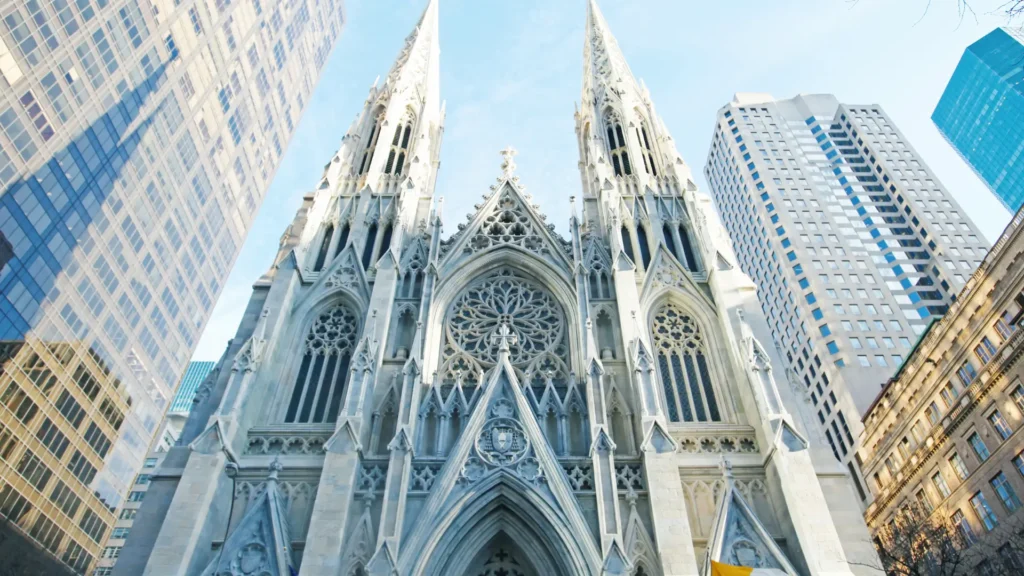
Saint Patrick’s Cathedral: A Beacon of Faith and Architectural Grandeur in New York City
Introduction
Situated majestically on Fifth Avenue in the heart of Manhattan, Saint Patrick’s Cathedral stands as an iconic symbol of faith, resilience, and architectural brilliance. This Neo-Gothic masterpiece not only serves as the spiritual home of the Archdiocese of New York but also captivates millions of visitors each year with its stunning design and rich history. Whether you’re a believer, an architecture enthusiast, or a curious traveler, Saint Patrick’s Cathedral offers a profound experience that resonates on multiple levels.
Historical Milestones
The origins of Saint Patrick’s Cathedral trace back to the mid-19th century, a period marked by rapid growth and transformation in New York City. The need for a grand cathedral became apparent as the Catholic population in the area surged. In 1858, the cornerstone was laid, and construction officially began in 1858 under the guidance of architect James Renwick Jr., who also designed the Smithsonian Institution Building in Washington, D.C. Tragically, Renwick passed away in 1857, and his vision was carried forward by his successor, Eugène-Emmanuel Viollet-le-Duc, a renowned French architect. The cathedral was consecrated in 1878, although it wasn’t fully completed until 1888, reflecting the ambitious scale and intricate details of the project.
Architectural Splendor
Saint Patrick’s Cathedral is celebrated for its breathtaking Neo-Gothic architecture, characterized by pointed arches, ribbed vaults, and flying buttresses that echo the grandeur of medieval European cathedrals. The façade is adorned with intricate stone carvings, towering spires, and expansive stained glass windows that bathe the interior in a kaleidoscope of colors. One of the most striking features is the grand rose window above the main entrance, which measures over 40 feet in diameter and is composed of more than 4,000 pieces of stained glass, each meticulously crafted to tell biblical stories and depict saintly figures.
Inside, the cathedral boasts an impressive 40-foot-high nave, soaring vaulted ceilings, and a magnificent altar that serves as the focal point for worship and ceremonies. The interior is embellished with ornate sculptures, detailed mosaics, and exquisite woodwork, all contributing to an atmosphere of reverence and awe. The cathedral’s acoustics are equally remarkable, making it a preferred venue for concerts and significant religious events, including papal visits and major liturgies.
Interesting Facts
- Longest-running Liturgical Music Program: Saint Patrick’s Cathedral is home to one of the oldest and most esteemed liturgical music programs in the United States. The cathedral choir, renowned for its exceptional performances, has been an integral part of the cathedral’s spiritual life since its inception.
- Surviving Historical Challenges: Throughout its history, the cathedral has withstood numerous challenges, including the Great New York City Fire of 1925, which threatened its structural integrity. Restoration efforts ensured that the cathedral not only survived but also retained its architectural beauty for future generations.
- A Hub for Social Justice: Beyond its religious functions, Saint Patrick’s Cathedral has been a center for social justice and community service. It played a significant role during the Civil Rights Movement and continues to advocate for various social causes, embodying its mission to serve both the faithful and the broader community.
- Iconic Pilgrimage Site: The cathedral attracts millions of pilgrims annually, especially during major religious events such as Easter and Christmas. It also serves as a pilgrimage site for those visiting New York City, offering a serene escape amidst the bustling urban landscape.
Economic Impact and Preservation
The construction of Saint Patrick’s Cathedral was a monumental undertaking, with the total cost exceeding $13 million by the time of its completion in 1888—a staggering sum for that era. Over the years, continuous preservation and restoration projects have ensured that the cathedral remains in pristine condition. Recent renovations have focused on enhancing structural stability, restoring stained glass windows, and upgrading the electrical and lighting systems to preserve the cathedral’s historical integrity while accommodating modern needs.
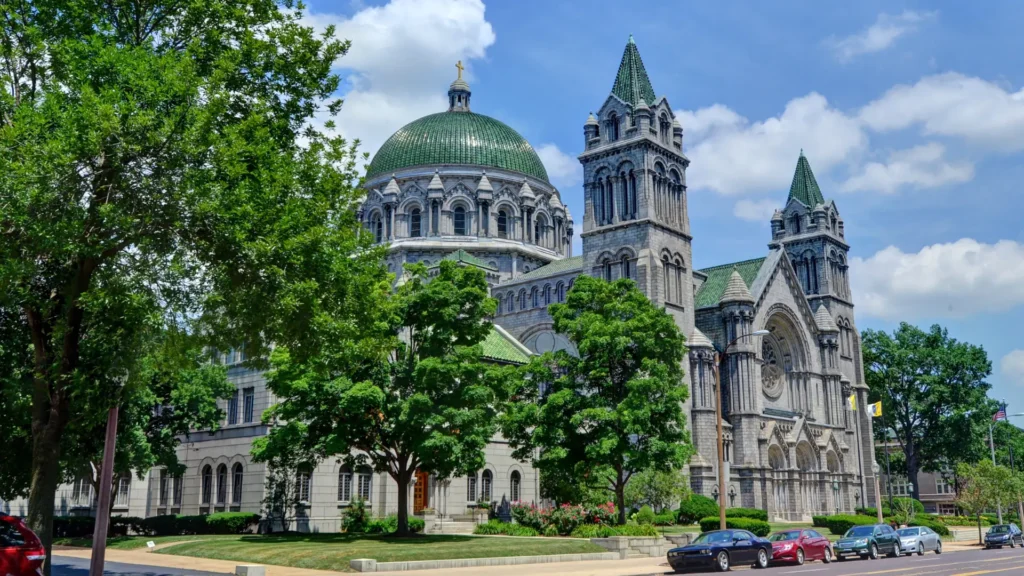
Cathedral Basilica of St. Louis: A Masterpiece of Faith and Artistry in the Heart of Missouri
An Architectural Triumph
Standing proudly in downtown St. Louis, the Cathedral Basilica of St. Louis—commonly known as the Old Cathedral—is a stunning example of Gothic Revival architecture that seamlessly blends grandeur with spiritual tranquility. Completed in 1847, it is one of the oldest cathedrals west of the Mississippi River and serves as the mother church of the Archdiocese of St. Louis. Designed by architect Thomas Francis Lininger, the cathedral features towering spires, intricate stone carvings, and an impressive façade that welcomes millions of visitors each year. Its elegant design not only reflects the rich religious heritage of the region but also showcases the craftsmanship and artistic vision of its creators.
Historical Significance and Legacy
The Cathedral Basilica of St. Louis has been at the forefront of the city’s religious and cultural development since its inception. Established by Bishop Peter Richard Kenrick, the cathedral was intended to serve as a beacon of Catholic faith in a rapidly growing frontier city. Throughout the 19th and 20th centuries, the cathedral played a pivotal role in community building, hosting numerous important events such as ordinations, royal weddings, and significant religious ceremonies. One of its most notable historical moments was the coronation of Bishop Kenrick in 1847, marking the official establishment of the archdiocese.
Artistic and Architectural Marvels
Inside the Cathedral Basilica of St. Louis lies a treasure trove of artistic wonders. The centerpiece is the stunning mosaics that adorn the ceiling and walls, created by Italian artisans from the mosaics of St. Peter’s Basilica in Rome. These intricate mosaics depict scenes from the Bible and the lives of saints, transforming the interior into a radiant space of light and color. The cathedral also boasts a magnificent rose window, exquisite stained glass, and beautifully crafted woodwork that contribute to its ethereal ambiance. Additionally, the cathedral houses a collection of sacred relics and historical artifacts, including the original pews from the 19th century, which offer a glimpse into the past and the enduring legacy of the Catholic Church in St. Louis.
Unique Features and Interesting Facts
- Largest Mosaic Ceiling in the Western Hemisphere: The Cathedral Basilica of St. Louis is home to the largest mosaic ceiling in the Western Hemisphere, covering over 1,700 square feet. These mosaics were meticulously crafted by European artists and transported to St. Louis piece by piece, showcasing remarkable dedication and craftsmanship.
- Vaulted Acoustics: The cathedral’s vaulted ceilings and spacious nave create exceptional acoustics, making it a favored venue for concerts and musical performances. The harmonious blend of architecture and sound enhances both spiritual and cultural events held within its walls.
- Historic Pipe Organ: The cathedral houses a magnificent pipe organ, originally built in the early 20th century. This grand instrument has been lovingly restored and continues to produce awe-inspiring music, adding to the cathedral’s rich auditory experience.
- Underground Crypt: Beneath the main sanctuary lies an underground crypt that serves as the final resting place for several archbishops of St. Louis. This solemn space adds a layer of historical depth and reverence to the cathedral’s already profound atmosphere.
- Preservation Efforts: Over the years, extensive preservation and restoration projects have been undertaken to maintain the cathedral’s structural integrity and artistic elements. These efforts ensure that the Cathedral Basilica of St. Louis remains a pristine and vibrant place of worship for future generations.
Community and Cultural Impact
Beyond its architectural and historical significance, the Cathedral Basilica of St. Louis is a cornerstone of the local community. It offers a variety of programs and services, including educational workshops, charitable initiatives, and interfaith dialogues that foster a sense of unity and support within the city. The cathedral also serves as a popular tourist destination, attracting visitors from around the world who come to admire its beauty and partake in its spiritual offerings.
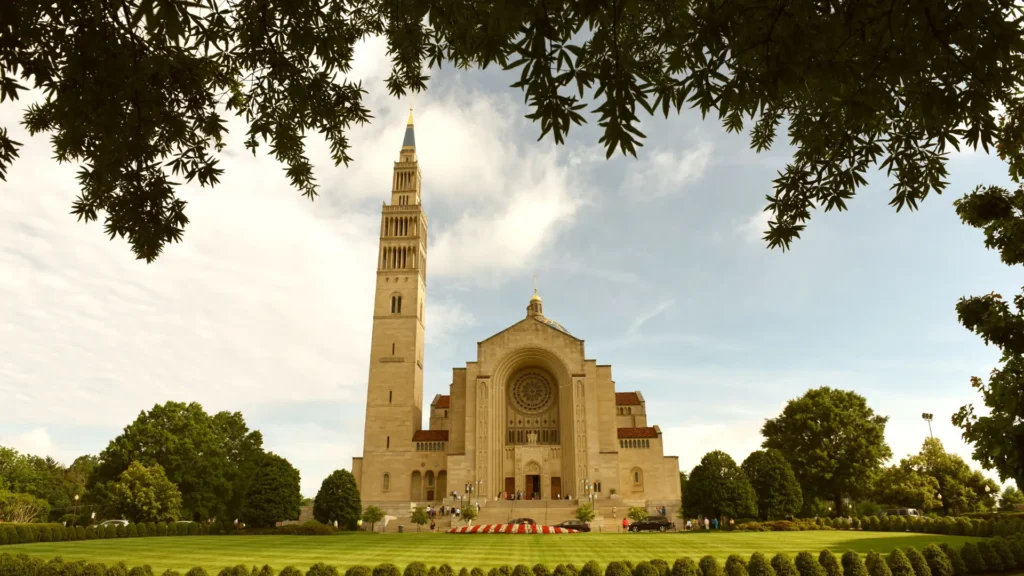
Basilica of the National Shrine of the Immaculate Conception: A Monument of Faith and Artistry
Introduction
Located in the heart of Washington, D.C., the Basilica of the National Shrine of the Immaculate Conception stands as a towering symbol of Catholic faith and architectural brilliance. As the largest Catholic church in the United States and the fourth largest in the world, this magnificent basilica not only serves as a place of worship but also as a cultural and historical landmark that attracts millions of visitors annually.
Architectural Grandeur
Spanning an impressive 102,000 square feet, the basilica is a harmonious blend of Gothic, Romanesque, and Byzantine architectural styles. The structure features a grand dome that reaches a height of 329 feet, making it the third largest dome globally. This dome offers stunning panoramic views of the nation’s capital, providing both spiritual and visual elevation to all who visit.
One of the most striking features of the basilica is its extensive collection of stained glass windows—over 1,000 in total—each meticulously crafted to depict scenes of faith, devotion, and historical significance. These windows flood the interior with vibrant colors, creating an ethereal atmosphere that enhances the spiritual experience. Additionally, the basilica boasts intricate mosaics, beautiful chapels dedicated to various saints, and meticulously detailed stone carvings that showcase the artistry and dedication poured into its construction.
Historical Journey
The journey to complete the Basilica of the National Shrine of the Immaculate Conception began in 1920, reflecting nearly a century of unwavering dedication and perseverance. Initially envisioned as a grand testament to Catholicism in America, the construction faced numerous challenges, including economic downturns, world wars, and shifts in architectural trends. Despite these obstacles, the project persisted, with significant milestones achieved along the way.
The basilica was finally completed in 2017, marking the culmination of an extraordinary effort that spanned nearly 100 years. The total cost of construction exceeded $600 million, a testament to the immense scale and complexity of the project. This prolonged timeline highlights the commitment to maintaining the integrity and vision of the original design while adapting to modern advancements and ensuring structural stability.
Unique Features and Interesting Facts
- Massive Dome: At 329 feet, the dome not only dominates the skyline but also incorporates advanced engineering techniques to ensure its stability and longevity.
- Extensive Stained Glass: With over 1,000 windows and 10,000 stained glass pieces, each window tells a unique story, reflecting diverse cultural and religious narratives from around the world.
- National Shrine Museum: The basilica houses a museum that showcases an impressive collection of religious art and artifacts, offering visitors a deep dive into the rich history and heritage of Catholicism.
- Global Pilgrimage Site: As a major pilgrimage destination, the basilica welcomes millions of visitors from across the globe, fostering a sense of unity and shared faith among diverse populations.
- Sustainability Efforts: Recent renovations have incorporated sustainable practices, including energy-efficient lighting and climate control systems, to preserve the basilica’s beauty while minimizing its environmental impact.
Cultural and Community Impact
Beyond its architectural splendor, the Basilica of the National Shrine of the Immaculate Conception plays a vital role in the community and the broader cultural landscape. It serves as a hub for religious events, including major Catholic ceremonies, presidential inaugurations, and significant national gatherings. The basilica’s extensive facilities support a variety of programs, such as educational workshops, spiritual retreats, and community service initiatives, reinforcing its role as a beacon of hope and inspiration.
The basilica also fosters interfaith dialogue and cultural exchange, promoting understanding and collaboration among different religious and cultural groups. Its commitment to social justice and charitable endeavors underscores the basilica’s mission to serve not only its congregation but also the wider community, embodying the principles of compassion and service.
Preservation and Future Vision
Ongoing preservation efforts ensure that the Basilica of the National Shrine of the Immaculate Conception remains a pristine and vibrant place of worship for future generations. Restoration projects focus on maintaining the structural integrity of the dome, repairing and enhancing stained glass windows, and preserving the intricate mosaics and carvings that adorn the interior.
Looking ahead, the basilica aims to expand its outreach and digital presence, making its rich heritage accessible to a global audience. Plans include virtual tours, enhanced online resources, and interactive exhibits that celebrate the basilica’s history and artistic achievements. By embracing modern technology, the basilica continues to honor its legacy while adapting to the needs of contemporary society.
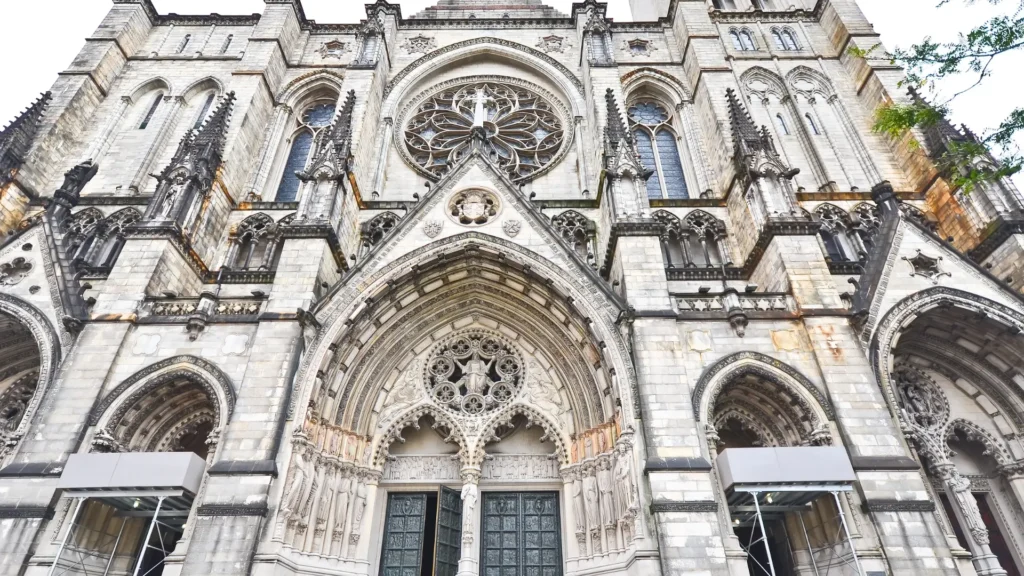
Cathedral Church of Saint John the Divine: New York City’s Unfinished Masterpiece
When you think of New York City’s iconic skyline, towering skyscrapers and the Statue of Liberty likely come to mind. Yet, nestled amidst the urban hustle stands the Cathedral Church of Saint John the Divine, a monumental testament to both architectural ambition and spiritual aspiration. Often referred to as “the Unfinished Cathedral,” this grand edifice offers a unique glimpse into a century-long journey of creation, cultural significance, and ongoing evolution.
A Vision Deferred but Not Forgotten
Construction of the Cathedral Church of Saint John the Divine began in 1892, inspired by the Gothic Revival style that sought to emulate the grandeur of medieval European cathedrals. From its inception, the cathedral was envisioned not just as a place of worship, but as a cultural hub—a space for art, music, and community gatherings. However, unlike many structures that reach completion within decades, Saint John the Divine remains perpetually in progress. This unfinished state has become a defining characteristic, symbolizing both the ever-evolving nature of the city and the enduring commitment of its congregation.
Architectural Wonders and Artistic Flourishes
Spanning approximately 104,000 square feet, the cathedral is one of the largest in the world, rivaling even the grandeur of European counterparts. Its façade is a breathtaking display of intricate stone carvings, soaring spires, and over 100 stained glass windows that filter vibrant light into the sacred spaces within. The centerpiece, a colossal rose window exceeding 40 feet in diameter, captivates visitors with its detailed depictions of biblical narratives and celestial motifs.
Inside, the nave can accommodate up to 2,200 people, creating an awe-inspiring space for both solemn ceremonies and lively community events. The interior is adorned with a blend of medieval-inspired sculptures and modern art installations, reflecting the cathedral’s unique fusion of tradition and contemporary creativity. One of the standout features is the Cloisters Garden, a serene retreat inspired by medieval European gardens, offering a peaceful sanctuary amidst the bustling city.
Interesting Tidbits and Unique Facts
- The Unfinished Symphony: The nickname “the Unfinished Cathedral” isn’t just a nod to its perpetual construction. Over the decades, various architectural plans have been proposed and shelved, each adding layers of complexity and beauty to the existing structure. This ongoing process allows the cathedral to adapt and incorporate new artistic and architectural trends, making it a living monument that evolves with time.
- Environmental Stewardship: In recent years, the cathedral has embraced sustainability, implementing green initiatives such as energy-efficient lighting and climate control systems. These efforts ensure that the building remains environmentally responsible while preserving its historical and aesthetic integrity.
- Cultural Nexus: Beyond its religious functions, Saint John the Divine serves as a vibrant cultural hub. It hosts an array of events, including art exhibitions, literary readings, and concerts, fostering a sense of community and cultural enrichment. The cathedral’s commitment to social justice and interfaith dialogue further underscores its role as a beacon of unity and compassion in a diverse metropolis.
- Historic Resilience: Throughout its long construction period, the cathedral has weathered numerous challenges, including economic downturns, world wars, and shifting societal priorities. Each obstacle has only strengthened the resolve of those dedicated to its completion, ensuring that the vision remains intact despite external pressures.
A Living Legacy in the Heart of the City
The Cathedral Church of Saint John the Divine is more than just an architectural marvel; it is a symbol of perseverance, community, and the harmonious blending of past and present. Its unfinished state invites curiosity and admiration, encouraging visitors to reflect on the beauty of imperfection and the ongoing journey of creation. As New York City continues to grow and transform, the cathedral stands as a steadfast reminder of the city’s rich cultural tapestry and the enduring spirit of its people.
Conclusion
Together, the Cathedral of Saint John the Baptist, Saint Patrick’s Cathedral, the Cathedral Basilica of St. Louis, the Basilica of the National Shrine of the Immaculate Conception, and the Cathedral Church of Saint John the Divine exemplify the pinnacle of religious architecture in the United States. Each of these magnificent structures showcases unique architectural styles, from Gothic Revival to Byzantine, and boasts rich histories that reflect the enduring legacy of faith and community. These churches not only serve as sacred places of worship but also stand as iconic cultural landmarks, attracting millions of visitors with their stunning beauty, intricate artistry, and significant cultural impact. Whether nestled in the historic streets of Savannah or towering in the heart of New York City, these churches inspire awe and admiration, embodying the harmonious blend of spirituality, artistry, and resilience that defines America’s most beautiful religious edifices.
This site is not endorsed by or affiliated with the Catholic Church, Knights of Columbus or any church or school listed.

